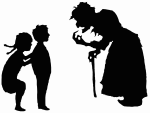Hansel and Gretel
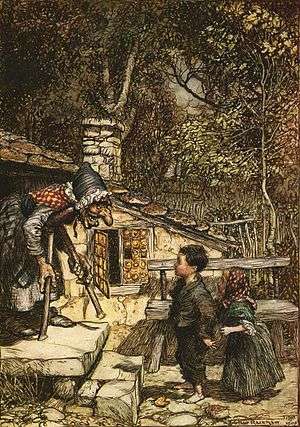
"Hansel and Gretel" (also known as Hansel and Grettel, Hansel and Grethel, or Little Brother and Little Sister) (/ˈhænsəl/ or /ˈhɑːnsəl/ and /ˈɡrɛtəl/; German: Hänsel und Gretel[lower-alpha 1] [ˈhɛnzl̩ ʊnt ˈɡʁeːtl̩]) is a well-known fairy tale of German origin, recorded by the Brothers Grimm and published in 1812. Hansel and Gretel are a young brother and sister kidnapped by a cannibalistic witch living deep in the forest in a house constructed of cake and confectionery. The two children save their lives by outwitting her. The tale has been adapted to various media, most notably the opera Hänsel und Gretel (1893) by Engelbert Humperdinck. Under the Aarne–Thompson classification system, "Hansel and Gretel" is classified under Class 327.
Plot
Hansel and Gretel are children whose father is a woodcutter. When a great famine settles over the land, the woodcutter's abusive second wife proposes to take the children into the woods and abandon them there, so that she and her husband will not starve. The woodcutter at first opposes the plan, but finally and reluctantly submits to his wife's scheme. Hansel and Gretel have overheard them. After the adults have gone to bed, Hansel sneaks out of the house and gathers made white pebbles, then returns to Gretel, assuring her that God will not forsake them.
The next day, the family walks deep into the woods, and Hansel lays a trail of white pebbles. After their parents leave them, the children wait for the moon to rise before following the pebbles back home. They return home safely, much to their stepmother's frustration. Once again, provisions become scarce, and the stepmother angrily orders her husband to take the children farther into the woods and leave them there to starve. Hansel and Gretel attempt to leave the house to gather more pebbles, but find the doors locked and escape impossible.
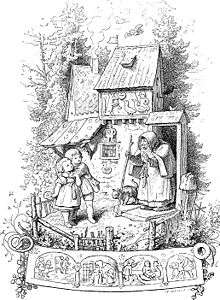
The following morning, the family treks into the woods. Hansel takes a slice of bread and leaves a trail of bread crumbs to follow home. However, after they are once again abandoned, the children find that birds have eaten the crumbs and they are lost in the woods.
After days of wandering, they follow a beautiful white bird to a clearing in the woods, where they discover a cottage built of bread and cakes, with windowpanes of sugar. Hungry and tired, the children begin to eat parts of the house when the door opens. An old woman, leaning on a crutch, emerges and lures them inside, offering dinner and cozy beds. The children do not know that their supposed benefactor is a bloodthirsty witch, who built her house of dainties to lure children to her so she may cook and eat them.
The following morning the witch locks Hansel in a cage, and forces Gretel to be her slave. The witch force-feeds Hansel regularly to fatten him up. She regularly demands that Hansel offer his finger for her to examine, but he cleverly proffers a bone instead. Because she is half-blind, she is fooled into thinking Hansel is still too thin to eat. After four weeks of this, the witch grows impatient and decides to eat Hansel anyway.
The witch prepares the oven for Hansel, but decides to kill Gretel as well. She coaxes Gretel to open the oven and prods her to lean over in front of it to see whether the fire is hot enough. Sensing the witch's intent, Gretel pretends that she does not understand what she is being told to do. Infuriated, the witch demonstrates, and Gretel instantly shoves her into the oven and slams and bolts the door shut. Gretel frees Hansel, and the pair discover chests of precious stones. Taking the jewels with them, they set off for home.
A swan ferries them across an expanse of water. Their father is overjoyed to find Hansel and Gretel alive, and tells them that their stepmother has died. The family is now rich, thanks to the witch's treasure, and they live happily ever after.
History and analysis
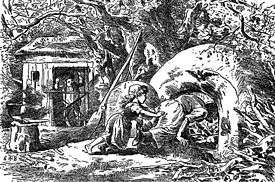
Jacob and Wilhelm Grimm heard "Hansel and Gretel" from Wilhelm's friend (and future wife) Dortchen Wild[1] and published it in Kinder - und Hausmärchen in 1812.[2] In the Grimms' version of the tale, the woodcutter's wife is the children's biological mother and the blame for abandoning them is shared between both her and the woodcutter himself. In later editions, some slight revisions were made: the wife became the children's stepmother, the woodcutter opposes her scheme to abandon the children and religious references are made. The sequence where the swan helps them across the river is also an addition to later editions.[3]
The fairy tale may have originated in the medieval period of the Great Famine (1315–1321),[4] which caused desperate people to abandon young children to fend for themselves, or even resort to cannibalism.
Folklorists Iona and Peter Opie indicate in The Classic Fairy Tales (1974) that "Hansel and Gretel" belongs to a group of European tales especially popular in the Baltic regions, about children outwitting ogres into whose hands they have involuntarily fallen. The tale bears resemblances to the first half of Charles Perrault's "Hop-o'-My-Thumb" (1697) and Madame d'Aulnoy's "Finette Cendron" (1721). In both tales, the Opies note, abandoned children find their way home by following a trail. In "Clever Cinders", the Opies observe that the heroine incinerates a giant by shoving him into an oven in a manner similar to Gretel's dispatch of the witch and they point out that a ruse involving a twig in a Swedish tale resembles Hansel's trick of the dry bone. Linguist and folklorist Edward Vajda has proposed that these stories represent the remnant of a coming-of-age rite-of-passage tale extant in Proto-Indo-European society.[5][6] A house made of confectionery is found in a 14th-century manuscript about the Land of Cockayne.[1]
The fact that the mother or stepmother dies when the children have killed the witch has suggested to many commentators that the mother or stepmother and the witch are metaphorically the same woman.[7] A Russian folk tale exists in which the evil stepmother (also the wife of a poor woodcutter) asks her hated stepdaughter to go into the forest to borrow a light from her sister, who turns out to be Baba Yaga, who is also a cannibalistic witch. Besides highlighting the endangerment of children (as well as their own cleverness), the tales have in common a preoccupation with food and with hurting children: the mother or stepmother wants to avoid hunger, while the witch lures children to eat her house of candy so that she can then eat them.[8] Another tale of this type is the French fairy tale The Lost Children.[9] The Brothers Grimm also identified the French Finette Cendron and Hop o' My Thumb as parallel stories.[10]
In Grimm's Fairy Tales this story is called Roland and May-Bird.[11] The Brothers Grimm story called Hansel and Gretel tells a quite different tale: Since their mother died and their father remarried, Hansel and his sister Gretel decided to run away to try their fortune in the world. As they enter a wood their cruel step-mother (who is also an evil fairy) enchants streams in the forest to turn Hansel and Gretel into animals. At Gretel's warning Hansel avoids the first and second streams (which would have turned him into a wolf or tiger respectively), but is too thirsty to resist the third, which turns him into a fawn. They both wander on until they find an abandoned cottage, where they move in and make a life for themselves. One day a king and his men are hunting in the forest and see Hansel. They give chase to him and eventually track him down to the cottage. The king enters and falls in love with Gretel, they get married and Hansel moves in with them. Gretel then tells the king of what has happened and he punishes the fairy step-mother, which turns Hansel back into a human.[12]
Cultural significance
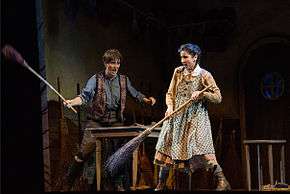
Hansel and Gretel's trail of breadcrumbs inspired the name of the navigation element "breadcrumbs" that allows users to keep track of their locations within programs or documents.[13] The opera Hänsel und Gretel by Engelbert Humperdinck is one of the most renowned operas, and is considered one of the most important German operas.[14]
See also
Notes
- ↑ In German, the names are diminutives of Johannes ("John") and Margarete ("Margaret"), respectively
References
Citations
- 1 2 Opie & Opie 1974, p. 237
- ↑ Tatar (2002), p. 44
- ↑ Tatar (2002), p. 45
- ↑ Raedisch (2013), p. 180
- ↑ Vajda (2010)
- ↑ Vajda (2011)
- ↑ Lüthi 1970, p. 64
- ↑ Tatar 2002, p. 54
- ↑ Delarue 1956, p. 365
- ↑ Tatar 2002, p. 72
- ↑ Brothers Grimm (1930), Grimm's Fairy Tales: Roland and May-Bird, George H. Doran Company
- ↑ Brothers Grimm (1930), Grimm's Fairy Tales: Hansel and Grettel, George H. Doran Company
- ↑ Mark Levene (18 October 2010). An Introduction to Search Engines and Web Navigation (2nd ed.). Wiley. p. 221. ISBN 978-0470526842. Retrieved June 24, 2016.
- ↑ Upton, George Putnam (1897). The Standard Operas (Google book) (12th ed.). Chicago: McClurg. pp. 125–129. ISBN 1-60303-367-X. Retrieved 15 October 2007.
Sources
- Delarue, Paul (1956). The Borzoi Book of French Folk-Tales. Alfred A. Knopf, Inc.
- Lüthi, Max (1970). Once Upon A Time: On the Nature of Fairy Tales. Frederick Ungar Publishing Co.
- Opie, Iona; Opie, Peter (1974). The Classic Fairy Tales. Oxford University Press. ISBN 978-0-19-211559-1.
- Raedisch, Linda (2013). The Old Magic of Christmas: Yuletide Traditions for the Darkest Days of the Year. Llewellyn Worldwide.
- Tatar, Maria (2002). The Annotated Classic Fairy Tales. BCA. ISBN 978-0-393-05163-6.
- Vajda, Edward (26 May 2010). The Classic Russian Fairy Tale: More Than a Bedtime Story (Speech). The World's Classics. Western Washington University.
- Vajda, Edward (1 February 2011). The Russian Fairy Tale: Ancient Culture in a Modern Context (Speech). Center for International Studies International Lecture Series. Western Washington University.
External links
| Wikisource has original text related to this article: |
| Wikimedia Commons has media related to Hansel and Gretel. |
- Project Gutenberg e-text
- SurLaLune Fairy Tale Pages: The Annotated Hansel and Gretel
- Original versions and psychological analysis of classic fairy tales, including Hansel and Gretel
- The Story of Hansel and Gretel
- Collaboratively illustrated story on Project Bookses
- A translation of the Grimm's Fairy Tale Hansel and Gretel
